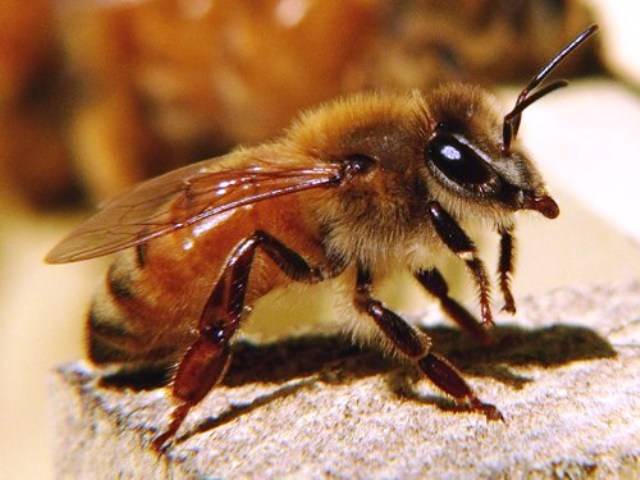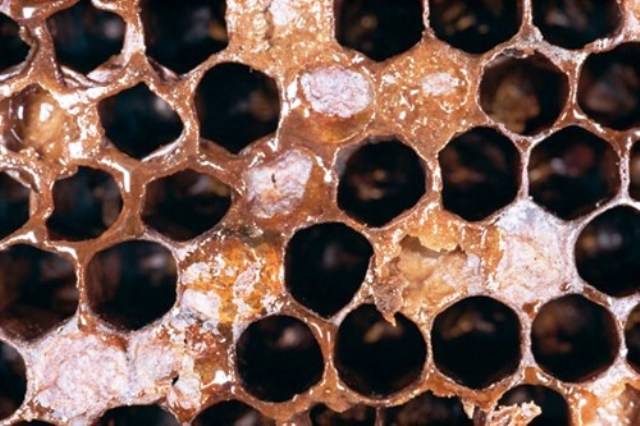
There are many diseases caused by various bacteria, fungi, protozoa, mites to the adults and the brood of honey-bees, leading to partial or total loss of colonies. An infected colony is not necessarily a diseased colony, for some infection in some circumstances can be present without any apparent effect on the colony. Similarly, a diseased colony is not necessarily an infected colony, for not all diseases are infectious for example dysentery and foulbrood are two diseases which are not infectious. Many beekeepers feel that if any infection is present in the colony, it is likely to spread, since the bees are living in a crowded colony. But there is another version that if during the course of evolution bee did not themselves have powerful defense against the spread of infection, they would not have survived. To understand the difference between diseased colony and infected colony, the two common controversial beliefs are discussed.

American foul brood disease, this is the most destructive bacterial disease affecting bee brood. The disease did not originate in, nor is it confined to, America. It is widely distributed wherever colonies of Apis mellifera are kept. In tropical Asia, where sunlight is abundant and temperatures are relatively high throughout the year, the disease seldom causes severe damage to bee broods.
Causes
American foul brood (AFB) is caused by a spore forming bacterium Bacillus larvae. It affects bee brood only.
Symptoms
At the initial stage of colony infection only a few dead older, larvae or pupae will be observed. Subsequently, the disease colonies in the apiary as a result of robbing, drifting worker, or contamination through the beekeeper's hive manipulations. The caps of the AFB infected cells, containing dead brood, are usually discoloured, darker than the caps of healthy cells, lightly protruding and fully closed. As the disease spreads unsealed brood cells can be easily distinguished from the normal, compact pattern of healthy brood cells observed in healthy colonies. The irregularly spaced brood cells should be opened gently and carefully inspected. The bee brood affected by AF'B is usually at the stage of older sealed larvae or young pupae, upright in the cells. At first the dead brood is dull white in colour, but it gradually changes to light brown, coffee brown, and finally dark brown or almost black. The consistency of the decaying brood is soft. The tests to determine, whether the death has been caused by AFB, are
stretch test, and
Brittle scale test.
1. Stretch test
A match stick is inserted into the body of the decaying larvae and then, gently and slowly, withdrawn. If the disease is present, the dead larvae will adhere to the top of the stick. However, it can be observed on decaying brood only.
1. Brittle scale test
Once the dead brood have dried into scales, the brood lies flat on the lower side of the cell wall, adhering closely to it. The scale, usually black or dark brown in colour, is brittle. Often, a fine thread like proboscis or tongue of the dead pupa can be seen protruding from the scale, angling towards the upper cell wall.

Control
(i) After thorough inspection, if colonies are found be infected by AFB they are killed. and all the hive materials belonging to the infected colony, including its honey, are destroyed by burning. Prior to burning the entire honey bee population of the infected colony -is killed, usually by poisonous gas and all the dead bees the supers the honey and the contaminated equipment are burned. When all the material had been completely burned, it is carefully buried deep.
(ii) Some progress has recently been made towards saving the costly equipments by construction of special fumigation chamber by the government or by co-operatives. The contaminated equipments are treated with ethylene dioxide under carefully regulated pressures.
(iii) Chemotherapeutic method of controlling AFB involves the administration of oxytetra-cycline (Terramycin) and sodium sulphatiazole in various formulations. with powdered sugar or sugar syrup. In order to avoid contaminating the honey with these antibiotics. care must be taken to ensure that no drugs are fed for four weeks prior to the arrival of the honey flow season.















